Nunki, Sigma Sagittarii (σ Sgr), is a hot blue-white main sequence star located in the constellation Sagittarius. With an apparent magnitude of 2.05, it is the second brightest star in the constellation, after Kaus Australis. Nunki lies at a distance of 228 light years from Earth. The massive, luminous star marks the vane of the celestial Archer’s arrow and forms the Teapot asterism with other bright stars in Sagittarius.
Star type
Nunki is a hot blue main sequence star of the spectral type B2.5 V. It is the only one among the 10 brightest stars in Sagittarius that is still fusing hydrogen in its core.
The hydrogen-fusing dwarf has a mass 7.8 times that of the Sun and a radius 4.5 times solar. With a surface temperature of 18,890 K, it is 3,300 times more luminous than the Sun. The star emits much of its light in the ultraviolet spectrum.
Nunki is a very fast spinner, with a rotational velocity of 165 km/s. In comparison, the Sun rotates at the speed of 1.997 km/s (or about 7 km/h).
Sigma Sagittarii has an estimated age of 31.4 million years. Even though it is much younger than the Sun, the star will be long gone by the time the Sun expands into a giant. Nunki will burn through its supply of hydrogen quickly due to its high mass and probably end its life within the next 50 million years. At the end of its life cycle, it will evolve into a white dwarf with a mass comparable to that of the Sun.
An X-ray survey of 12 nearby near-main sequence B stars conducted using the Roentgen Satellite (ROSAT) in the 1990s revealed that Nunki is a source of X-ray emissions. It has an X-ray luminosity of 1.2 x 1028 erg s-1.
Nunki has an optical companion, a 10th magnitude star at a separation of about 5.2 arcminutes.
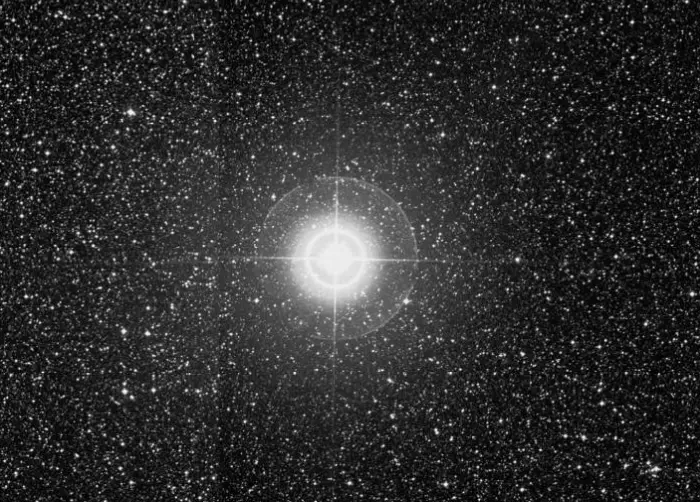
Nunki (Sigma Sagittarii), image: Wikisky
Name
The name Nunki (pronunciation: /ˈnʌŋki/) has an Assyrian or Babylonian origin, but its meaning is unclear. The name was recovered by archaeologists and revealed by Richard Hinckley Allen in his book Star Names: Their Lore and Meaning (1899).
Sigma Sagittarii was identified with Nunki, the Star of the Proclamation of the Sea, as mentioned in the Euphratean Tablet of the Thirty Stars. The sea in question refers to the area of the sky occupied by several constellations associated with water: Delphinus (the Dolphin), Aquarius (the Water Bearer), Capricornus (the Sea Goat), Pisces (the Fish) and Piscis Austrinus (the Southern Fish). The Greek astronomer Aratus called this area the Water around 270 BCE.
Nunki was associated with the city of Eridu and the Akkadian Gu-shi-rab‑ba, the Yoke of the Sea, the patron asterism of the city. Ancient Sumerians believed that Eridu was the first city in the world. In Sumerian mythology, it was the home of Enki (known as Ea in Akkadian and Babylonian myths), the god of water, creation, knowledge, crafts and mischief. Gu-shi-rab‑ba was identified by some as the star pattern formed by Nunki with the fainter Ascella (Zeta Sagittarii) and Albaldah (Pi Sagittarii).
The International Astronomical Union’s (IAU) Working Group on Star Names (WGSN) officially approved the name Nunki for Sigma Sagittarii on August 21, 2016.
Sigma Sagittarii was historically also known as Sadira. The 17th century Egyptian astronomer Al Achsasi al Mouakket listed the star as Thanih al Sadirah, “the second returning ostrich,” in his Calendarium, written around the year 1650. Sigma, Phi, Zeta, Chi and Tau Sagittarii were the Arabic Al Naʽām al Ṣādirah, the Returning Ostriches, while Kaus Borealis was known as their keeper.
The English astrologer Vivian E. Robson listed Sigma Sagittarii as Pelagus (“the sea” in Latin) in his book The Fixed Stars and Constellations in Astrology.
In traditional Chinese astronomy, Nunki was known as 斗宿四 (Dǒu Xiù sì), the Fourth Star of the Dipper. The name referred to the Chinese Dipper asterism, also formed by Phi Sagittarii, Kaus Borealis (Lambda Sagittarii), Polis (Mu Sagittarii), Tau Sagittarii, and Ascella (Zeta Sagittarii). The asterism was part of the larger Dipper mansion, one of the northern mansions of the Black Tortoise.
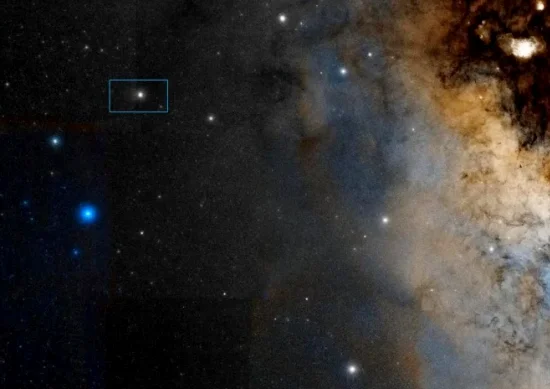
Nunki (Sigma Sagittarii), image: Wikisky
Facts
Shining at magnitude 2.05, Nunki is the 52nd brightest star in the sky. It is only slightly fainter than Algieba in the constellation Leo, Polaris in Ursa Minor, Hamal in Aries and Diphda in Cetus, but outshines Menkent in Centaurus and Alpheratz and Mirach in Andromeda.
Nunki lies only 3.45 degrees south of the ecliptic, which means that it can be occulted by the Moon and by planets. Occultation by a planet takes place far less frequently; the last one occurred on November 17, 1981, when the star was occulted by Venus. The occultation was visible from Europe around sunset.
Nunki is one of the 58 stars selected for use in navigation. The only other navigational star in Sagittarius is Kaus Australis, the constellation’s brightest star. Navigational stars are useful in the field of celestial navigation because they are some of the brightest and most identifiable stars in the night sky. Nunki and Kaus Australis both shine at second magnitude and are part of the Teapot, a prominent asterism located in the rich field of the Milky Way’s bright band.
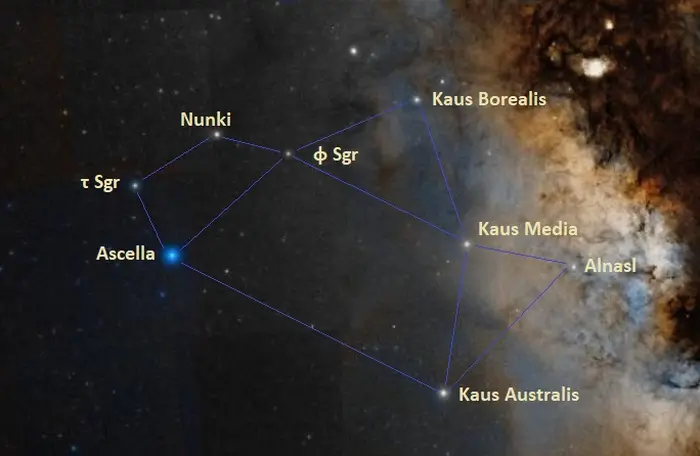
The Teapot in Sagittarius, image: Wikisky (DSS2)
Nunki forms the Teapot with Kaus Australis (Epsilon Sagittarii), Ascella (Zeta Sagittarii), Kaus Media (Delta Sagittarii), Kaus Borealis (Lambda Sagittarii), Alnasl (Gamma2 Sagittarii), Phi Sagittari, and Tau Sagittarii.
Nunki and Tau Sagittarii form the Teapot’s handle, Kaus Australis, Kaus Media, Ascella and Phi Sagittarii form the body, Kaus Borealis marks the top of the lid, and Alnasl marks the spout. On clear, dark nights, the Milky Way appears as steam coming from the Teapot.
Nunki is also a part of the Little Milk Dipper, a smaller pattern formed by five of the eight stars that outline the Teapot: Nunki (Sigma Sagittarii), Ascella (Zeta Sagittarii), Kaus Borealis (Lambda Sagittarii), Phi and Tau Sagittarii.
Location
Nunki is very easy to find because it is one of the bright stars that form the conspicuous summer asterism known as the Teapot. The star marks the top left corner of the asterism.
For northern observers, the Teapot is prominent above the southern horizon in the summer months. It appears just left of the bright constellation figure of Scorpius and can be found by following the imaginary line extended through the body of the celestial Eagle (Aquila).
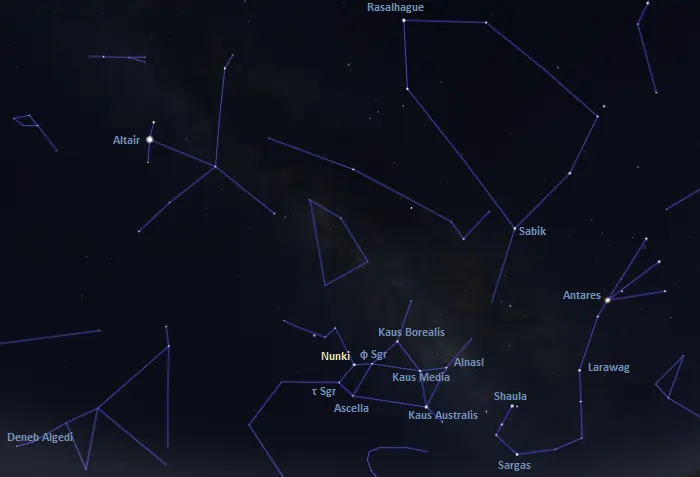
The location of Nunki (Sigma Sagittarii), image: Stellarium
There are several notable globular clusters in the vicinity of Nunki. The Sagittarius Cluster (Messier 22) has an apparent magnitude of 5.1 and is located about 10,600 light-years from the solar system. The cluster lies about 2.5 degrees northeast of Kaus Borealis, located at the top of the Teapot. It can be found by extending a line from Tau Sagittarii through Nunki.
A line drawn in the opposite direction points towards the globular cluster Messier 55, popularly known as the Summer Rose Star or Specter Cluster. M55 shines at magnitude 6.3 from a distance of 17,600 light-years.
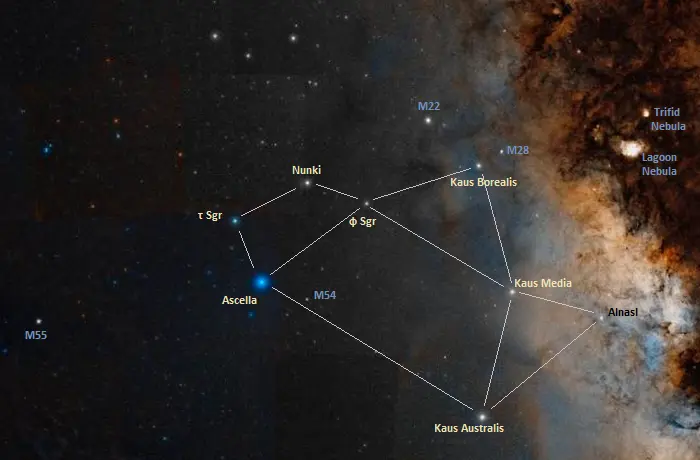
Deep sky objects near Nunki, image: Wikisky (DSS2)
Messier 28 can be seen less than a degree northwest of Kaus Borealis. With a visual magnitude of 6.8, it is slightly dimmer than M22. It lies at an approximate distance of 18,260 light years from Earth.
Messier 54 lies west and slightly south of Ascella. It was the first globular cluster discovered that belongs to a different galaxy. It lies 87,400 light-years away and is believed to belong to the Sagittarius Dwarf Elliptical Galaxy (SagDEG).
Nunki and Kaus Borealis can be used to find two bright nebulae in Sagittarius. A line from Nunki through Kaus Borealis leads to the Trifid Nebula (Messier 20) and the open cluster Messier 21 (Webb’s Cross). The brighter and larger Lagoon Nebula (Messier 8) appears just southeast of the Trifid.
Constellation
Nunki is located in the constellation of Sagittarius. Representing the Archer, the constellation is usually depicted as a centaur with a bow and arrow, and can be seen in the rich star field of the Milky Way in the southern sky.
Like all constellations of the zodiac family, Sagittarius was listed by the Greco-Roman astronomer Ptolemy of Alexandria as one of the 48 ancient constellations. In Greek mythology, it is associated with a centaur and with the satyr Crotus, who is said to have invented archery.
Sagittarius occupies 867 square degrees of the southern sky and is the 15th largest of the 88 constellations. It appears between the brighter Scorpius and fainter Capricornus on the ecliptic (the Sun’s apparent path across the sky).
Sagittarius is one of the most distinctive southern constellations. With seven stars brighter than magnitude 3.0, it is easily spotted even from light-polluted areas. The constellation’s brightest star, the hot blue giant Kaus Australis, shines at magnitude 1.85 from a distance of 143 light-years.
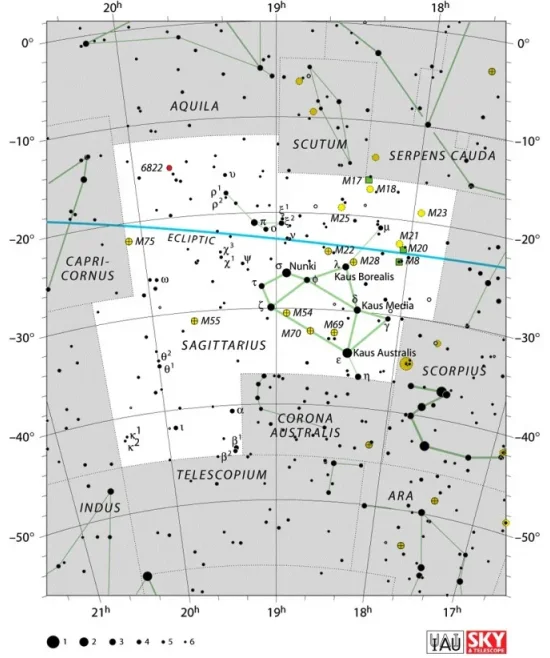
Sagittarius constellation map by IAU and Sky&Telescope magazine
Other notable stars in Sagittarius include the blue supergiant Polis (Mu Sagittarii), the blue giant Phi Sagittarii, the triple star system Zeta Sagittarii (Ascella), the red giant Eta Sagittarii, the F-type bright giant Albaldah (Pi Sagittarii), the orange subgiant Kaus Borealis (Lambda Sagittarii), and the orange giants Kaus Media (Delta Sagittarii), Alnasl (Gamma2 Sagittarii) and Tau Sagittarii.
Sagittarius also contains the luminous blue variable V4647 Sagittarii, popularly known as the Pistol Star, the Wolf-Rayet star WR 104, and the variable red supergiants VX Sagittarii and KW Sagittarii.
Sagittarius is a popular target for stargazers because it contains a number of interesting deep sky objects. These include the bright nebulae Messier 8 (the Lagoon Nebula), Messier 17 (the Omega Nebula) and Messier 20 (the Trifid Nebula), the open clusters Messier 18, Messier 21 and Messier 23, and the globular clusters Messier 22 and Messier 28.
Sagittarius is also home to Sagittarius A*, the black hole at the centre of the Milky Way galaxy. The constellation hosts the open clusters known as the Quintuplet Cluster and the Arches Cluster near the Galactic centre, the globular clusters NGC 6544 and NGC 6723, the Sagittarius Dwarf Elliptical Galaxy, Barnard’s Galaxy, and the planetary nebulae NGC 6578, NGC 6565, the Little Gem Nebula (NGC 6818), the Red Spider Nebula (NGC 6537), and the Eye of Sauron Nebula (M 1-42).
The best time of the year to observe the stars and deep sky objects in Sagittarius is during the month of August, when the celestial Archer appears higher above the horizon in the early evening. The entire constellation is visible from locations south of the latitude 55° N.
The 10 brightest stars in Sagittarius are Kaus Australis (Epsilon Sgr, mag. 1.85), Nunki (Sigma Sgr, mag. 2.05), Ascella (Zeta Sgr, mag. 2.59), Kaus Media (Delta Sgr, mag. 2.70), Kaus Borealis (Lambda Sgr, mag. 2.82), Albaldah (Pi Sgr, mag. 2.89), Alnasl (Gamma² Sgr, mag. 2.98), Eta Sagittarii (mag. 3.11), Phi Sagittarii (mag. 3.17), and Tau Sagittarii (mag. 3.326).
Nunki – Sigma Sagittarii
| Spectral class | B2.5 V |
| U-B colour index | –0.761 |
| B-V colour index | –0.204 |
| Apparent magnitude | 2.05 |
| Absolute magnitude | −2.17 |
| Distance | 228 ± 5 light-years (70 ± 1 parsecs) |
| Parallax | 14.32 ± 0.29 mas |
| Radial velocity | –11.2 km/s |
| Proper motion | RA: +15.14 ± 0.29 mas/yr |
| Dec.: –53.43 ± 0.19 mas/yr | |
| Mass | 7.8 ± 0.2 M☉ |
| Luminosity | 3,300 L☉ |
| Radius | 4.5 R☉ |
| Temperature | 18,890 K |
| Age | 31.4 ± 0.4 million years |
| Rotational velocity | 165 km/s |
| Constellation | Sagittarius |
| Right ascension | 18h 55m 15.92650s |
| Declination | –26° 17′ 48.2068″ |
| Names and designations | Nunki, Sigma Sagittarii, Sigma Sgr, σ Sagittarii, σ Sgr, 34 Sagittarii, Sadira, HD 175191, HR 7121, HIP 92855, GC 25941,GCRV 11359, SAO 187448, PPM 269078, FK5 706, GSC 06868-01829, PLX 4365.01, ALS 15063, CD-26 13595, CPD-26 6590, JP11 3036, WEB 16074, PMC 90-93 501, SRS 30706, UBV 16048, UBV M 23293, UCAC4 319-206211, IRAS 18521-2621, 2MASS J18551592-2617481, TD1 23447, TIC 91093307, TYC 6868-1829-1, WISE J185515.72-261750.5, CCDM J18552-2618A, IDS 18491-2625 A, WDS J18553-2618Aa,Ab |